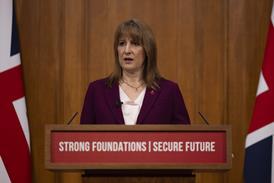The Pensions Regulator (TPR) is to engage with some of the country’s biggest pensions administrators after a pilot programme uncovered areas for improvement.
The regulator has been working with “three strategically significant administrators” since last year, focusing on “risk factors” including data management and engagement with trustees and scheme managers.
It comes as TPR also revealed that “a significant number” of administration providers it surveyed had “no plans to increase their IT investment over the next two years”
In a blog published last week, interim director of supervision and market oversight David Walmsley said the regulator would build on this work by inviting “10 to 15” of the largest administration providers to engage in further collaboration on a voluntary basis.
It wants to work with in-house and third-party administrators to “better understand the challenges these administrators face and, through our active engagement, enhance outcomes aimed at protecting savers and enhancing trust in the pension system”.
A formal review of TPR’s operations was published in October last year, led by Mary Starks, former director of competition at the Financial Conduct Authority. It recommended that the regulator work with the Department for Work and Pensions to “understand the costs and benefits of extending TPR’s remit to cover pension administrators and introduce formal standards and authorisation for professional trustees”.
Investment in technology
Focus areas for the new engagement programme will include financial stability, as administrators seek to balance cost efficiency and high-quality service, as well as data and technology issues.
Walmsley highlighted “years of limited investment” in technology, which meant that many administrators were still operating on legacy systems.
A TPR survey of administration providers found that “a significant number of administrators have no plans to increase their IT investment over the next two years”. Providers serving smaller schemes and in-house administrators were the least likely to have investment plans, the regulator said.
Walmsley emphasised that “exceptional pension administration demands significant investment”. He highlighted the regulator’s work in partnership with the Pensions Administration Standards Association, which provides guidance and best practice across various areas of administration.
On cybersecurity, Walmsley said TPR would steer firms towards “robust risk and incidence management practices and clear and fast member communications” if a security issue arises.
The regulator will also look at risk and change management processes to understand how administrators cope with regulatory changes and recruitment, and to assist firms with finding “practical solutions that support effective service delivery to their end users”.
“Trustees should value administration highly and recognise the value in secure and innovative service offerings,” Walmsley said. “They and administrators must work together, driven by a shared purpose, to address the challenges ahead.”
He added: “Our ongoing efforts aim to help elevate administration services, ensuring positive outcomes for savers and bolstering confidence in the pension system.
“These are indeed exciting times in the pensions industry, offering opportunities for innovation and resourceful solutions. Together, we are shaping a stronger, more resilient industry and paving the way for informed regulatory decisions.”
A long time coming
TPR’s push to engage with administration providers comes after the recent Norton Motorcycles scandal highlighted a gap in regulatory oversight.
Earlier this year, Sir Stephen Timms, then chair of the Work and Pensions Select Committee, wrote to the then-work and pensions secretary Mel Stride to highlight the committee’s findings, as the general election had prevented it from finalising a full report.
One of the committee’s recommendations was that government investigate whether TPR’s remit should be extended to include administrators.
The letter detailed issues with two administration providers that worked with Norton. The first, T12, was flagged to TPR by whistleblowers, but the replacement, Liddell Dunbar, was able to take on the scheme despite one of the owners admitting that the company had no knowledge of pensions regulation.
Sir Stephen’s letter also stated that TPR was “working with the largest administrators to develop a voluntary supervisory regime”.
Since the Norton-related concerns were raised, HM Revenue & Customs – which oversees the registration of pension schemes and administrators – has tightened its requirements.
TPR still has no regulatory powers over administrators directly, but has had an “administrator relationships function” since January 2022, which is designed to engage with third-party administrators. It is this unit that has led the engagement work so far and will continue to do so as it expands.
Further reading
Norton fraud victims share £9.8m compensation payout (20 August 2024)
TPR: Why pension administrators are in the regulator’s sight (14 September 2023)
Dashboards latest: Trafalgar House warns of admin ‘tech debt’ (6 August 2024)






















